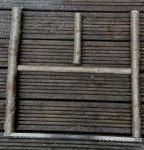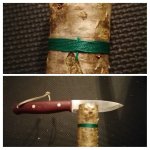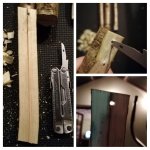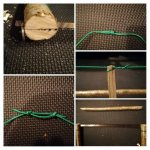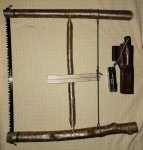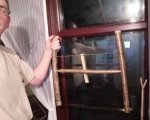Bucksaw.. First Attempt
- Thread starter Greg
- Start date
-
Come along to the amazing Summer Moot (21st July - 2nd August), a festival of bushcrafting and camping in a beautiful woodland PLEASE CLICK HERE for more information.
You are using an out of date browser. It may not display this or other websites correctly.
You should upgrade or use an alternative browser.
You should upgrade or use an alternative browser.
Give the other tasks a go too..I like, very good job....think I'll have a go too
Bushclass Index
I hope to keep this organized. I am going to have a list for required lessons and elective lessons. I had to move the Advanced cert requirements to post #2. REQUIRED FOR BASIC CERT 1.Feather Sticks and Shavings Lesson Student Practice 2. 5 Man-made Tinders Lesson Student Practice 3. The...
bushcraftusa.com
I'm not an experienced wood carver / carpenter by any stretch of the imagination but this took me about 3hrs not including going out into the woods to coppice the hazel.Very smart! How long would you say it took you?
I gave it a go on some hazel pieces but to be honest I think it needs a better stiffer blade.. I bought a very cheap saw blade just for this build task and its a bit too flexible.Have you had chance to use it yet? Does it saw well? It looks great!
I would be very surprised if the problem was blade flexibility. The blade is under tension, and it is the tension that stops it from flopping side to side when cutting.
I think you used dead hazel, but cannot be sure. If you use live hazel there can be flex which robs tension. If you have long enough to wait, pealing the bark off the sticks will greatly speed their drying time and with a little warmth you could have them stiffen up nicely in a week or so. The very best saws I have made were made from dead standing spruce saplings. Spruce being light and stiff, also can be dead standing for a while before rot sets in.
Another thing that will greatly help tension is using more turns of cord, and using a non-stretch cord. If the premise is using boot laces then one makes do. Nylon has a lot of stretch. I think that natural fibres like sisal and linen have low stretch, and polyester is much better if you use synthetic. Using more turns puts each strand under less tension, so less stretch, for a given total, but more than that, the bulk of the bundle forces strands to travel further when twisted. Two parallel cords don't get shortened per turn as much as four in parallel.
Finally, moving the cord further up away from the cross member will increase tension.
I am very interested how this style holds up in use. I had been lead to believe that single cross member/single string designs can have stability problems with tendency to become parallelograms from hand pressure/blade resistance.
I also like a longer blade, since you lose blade length passing through the handles, unlike in a fixed metal frame bow saw. My travel blade is 28 or 30 inches. On a couple trips we have needed to tackle 10" logs and the extra stroke length has been most welcome. They really do teach sawing sensitivity.
 DSC02253 by Last Scratch, on Flickr
DSC02253 by Last Scratch, on Flickr
I think you used dead hazel, but cannot be sure. If you use live hazel there can be flex which robs tension. If you have long enough to wait, pealing the bark off the sticks will greatly speed their drying time and with a little warmth you could have them stiffen up nicely in a week or so. The very best saws I have made were made from dead standing spruce saplings. Spruce being light and stiff, also can be dead standing for a while before rot sets in.
Another thing that will greatly help tension is using more turns of cord, and using a non-stretch cord. If the premise is using boot laces then one makes do. Nylon has a lot of stretch. I think that natural fibres like sisal and linen have low stretch, and polyester is much better if you use synthetic. Using more turns puts each strand under less tension, so less stretch, for a given total, but more than that, the bulk of the bundle forces strands to travel further when twisted. Two parallel cords don't get shortened per turn as much as four in parallel.
Finally, moving the cord further up away from the cross member will increase tension.
I am very interested how this style holds up in use. I had been lead to believe that single cross member/single string designs can have stability problems with tendency to become parallelograms from hand pressure/blade resistance.
I also like a longer blade, since you lose blade length passing through the handles, unlike in a fixed metal frame bow saw. My travel blade is 28 or 30 inches. On a couple trips we have needed to tackle 10" logs and the extra stroke length has been most welcome. They really do teach sawing sensitivity.
 DSC02253 by Last Scratch, on Flickr
DSC02253 by Last Scratch, on Flickr
Last edited:
I am doing the same Bushclass lesson as Greg at the moment ... for the third or fourth time, just for fun... and had wobbly blade issues too. I tried replacing the paracord tightening cord with natural fiber Sash cord and it worked a treat - no more wobble and I got so much tension I almost destroyed the frame!!
The lesson specifically says "use any cordage" and like the rest of the Bushclass lessons allows a lot of "Do it your way" wriggle room.
Thanks for the tip Chris. Next time I will try the split cross bar as well as I too find the single crossmember leads to a parallelogram saw!
The lesson specifically says "use any cordage" and like the rest of the Bushclass lessons allows a lot of "Do it your way" wriggle room.
Thanks for the tip Chris. Next time I will try the split cross bar as well as I too find the single crossmember leads to a parallelogram saw!
John,
For your next one, try the Kelly Harlton H-saw. He worked with Mors and came up with a two-point tensioning system that is meant to do away with the need (and fiddle) of the split or lashed cross member. Next time I make one I want to try that.
Another thing I found, splitting the wood to accept the blade works, but it is still better to cut out a kerf. Since you are cutting along the grain, most saws we carry don't work so well. I found some electric jigsaw blades that have much more of a rip-saw tooth shape and was able to make up a little handle. That is now part of the kit I carry, along with the main blade, bolts and 4mm non-stretch cord.
For your next one, try the Kelly Harlton H-saw. He worked with Mors and came up with a two-point tensioning system that is meant to do away with the need (and fiddle) of the split or lashed cross member. Next time I make one I want to try that.
Another thing I found, splitting the wood to accept the blade works, but it is still better to cut out a kerf. Since you are cutting along the grain, most saws we carry don't work so well. I found some electric jigsaw blades that have much more of a rip-saw tooth shape and was able to make up a little handle. That is now part of the kit I carry, along with the main blade, bolts and 4mm non-stretch cord.
I would be very surprised if the problem was blade flexibility. The blade is under tension, and it is the tension that stops it from flopping side to side when cutting.
I think you used dead hazel, but cannot be sure. If you use live hazel there can be flex which robs tension. If you have long enough to wait, pealing the bark off the sticks will greatly speed their drying time and with a little warmth you could have them stiffen up nicely in a week or so. The very best saws I have made were made from dead standing spruce saplings. Spruce being light and stiff, also can be dead standing for a while before rot sets in.
Another thing that will greatly help tension is using more turns of cord, and using a non-stretch cord. If the premise is using boot laces then one makes do. Nylon has a lot of stretch. I think that natural fibres like sisal and linen have low stretch, and polyester is much better if you use synthetic. Using more turns puts each strand under less tension, so less stretch, for a given total, but more than that, the bulk of the bundle forces strands to travel further when twisted. Two parallel cords don't get shortened per turn as much as four in parallel.
Finally, moving the cord further up away from the cross member will increase tension.
I am very interested how this style holds up in use. I had been lead to believe that single cross member/single string designs can have stability problems with tendency to become parallelograms from hand pressure/blade resistance.
I also like a longer blade, since you lose blade length passing through the handles, unlike in a fixed metal frame bow saw. My travel blade is 28 or 30 inches. On a couple trips we have needed to tackle 10" logs and the extra stroke length has been most welcome. They really do teach sawing sensitivity.
DSC02253 by Last Scratch, on Flickr
It was green wood hazel I used.. Probably just my DIY skills being crap..
Gotta start somewhere! I remember using green birch and having some problems. Pealed it, and a few days later it was a lot stiffer. Bark removal really does help. For long term durability taking green wood and letting it dry can be better than trying to use natural standing dead, which so often has started to rot a little.
Of all the stuff that one can make, I think bucksaws are a really great example to show people a bit of bushcraft. The materials look so simple, just sticks, but you put them together and they make something that WORKS, that does a job people are familiar with.
Of all the stuff that one can make, I think bucksaws are a really great example to show people a bit of bushcraft. The materials look so simple, just sticks, but you put them together and they make something that WORKS, that does a job people are familiar with.
Maybe I will leave it to season for a while then retention it, see what happens.. But you're spot on with what you said about it turning into a parallelogram.. That's what happened.
I'll get a longer blade for my next one.
I'll get a longer blade for my next one.
I took it apart this morning, made some changes and tried it again.
It's now working how a saw should.
It's now working how a saw should.
That looks solid 
Square lashing is the way I was shown as a scout. I suppose the purists will say it takes longer to take down but it's also much quicker to make! We also used 'T' lashing - the cross piece is notched at each end to sit snug against the uprights and the lashing goes over the three pieces. To be honest though I don't think there's any advantage over the way you've done it and it may even be less stable.
Square lashing is the way I was shown as a scout. I suppose the purists will say it takes longer to take down but it's also much quicker to make! We also used 'T' lashing - the cross piece is notched at each end to sit snug against the uprights and the lashing goes over the three pieces. To be honest though I don't think there's any advantage over the way you've done it and it may even be less stable.
Similar threads
- Replies
- 10
- Views
- 444
- Replies
- 3
- Views
- 408
- Replies
- 37
- Views
- 1K
- Replies
- 14
- Views
- 703
- Replies
- 118
- Views
- 4K



